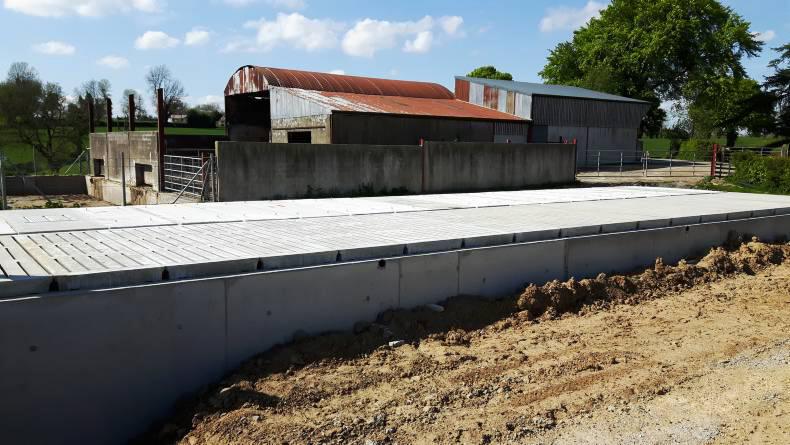Over the past three weeks the Irish Farmers Journal investigated the main slurry storage options available to farmers. There are pluses and minuses to every option and the slurry storage choice a farmer will end up selecting comes down to farm circumstances. The main options we looked at were concrete tanks, geomembrane lined slurry stores (lagoons) and over-ground circular slurry stores (round tower). This week we provide a summary of the main findings. Firstly, one should remember that there are several different points to consider when choosing slurry storage including:
In this article we have compared the three main slurry storage options for a 100-cow herd. The aim is to show what is available. Each can play a role depending on the farmers situation.
Advantages of concrete tanks
Disadvantages of concrete tanks
Costs

Figure 1 shows the plans for a concrete tank that a farmer may build for slurry storage. The concrete tank has capacity for 16 weeks of slurry storage for 100 cows. The tank is 56.5m long, 4.7m wide and 2.7ft deep (9ft). It has a usable volume of 571.05m3.

Table 1 shows the Department reference costs for building this tank and the maximum grant aid available for a successful TAMS II application. This concrete tank would cost €39,020 excluding VAT, according to those reference costs. A safety fence to surround the tank would cost €6,432 excluding VAT and a circulation pipe system would cost a further €811 excluding VAT. The 100-cow tank could be slatted at a cost of approximately €12,605 excluding VAT.
Comment
Some farmers prefer to install a concrete tank because they feel it is the most durable option – there is the possibility of building animal housing above the tank in the future and some county councils prefer to give planning permission for concrete tanks rather than lagoons. However, on the other hand, not every site is suitable for constructing a concrete slurry tank. The cost of building a concrete tank can also be enough to prevent farmers choosing this option.
Interestingly, in the costings we found there was not a huge difference between erecting a safety fence around an open slurry tank to kitting the tank out with slats instead.

Advantages of a lagoon
Disadvantages of a lagoon
Costs

Figure 2 shows the plans of a lagoon designed to hold 16 weeks of slurry for a 100-cow herd on unroofed cubicles. The lagoon has capacity for 350,000 gallons of slurry. It is 25.5m long, 25.5m wide and 3.6m deep. There are two concrete-based agitation points at either end of the lagoon to support a tractor and lagoon agitator. Table 2 shows the Department’s reference costs for building this size of lagoon and the maximum grant aid available for a successful TAMS II applicant. This lagoon costs a total of €37,485 excluding VAT to build.

Comment
In our comparisons, lagoons seemed to be the least advantageous of all the options. However, the comparisons in this 100-cow example may be somewhat unfair because the real benefit of lagoons in my opinion are on greenfield sites where large-scale slurry storage is required at lower costs. Typically, the cost benefit only really kicks in when lagoons are erected for 200+ cow herds built to accommodate slurry from new large cubicle sheds and dairy washings.

Advantages
Disadvantages

Costs
Figure 3 shows the plans of a tank designed to hold 16 weeks of slurry for a 100-cow herd. The tank has capacity for 155,450 gallons or 707m3 of slurry. The tank has a radius of 7.26m and is three rings (4.27m) high. Table 3 shows the Department’s reference costs for building this size of over-ground tank and the maximum grant aid available for a successful TAMS II applicant.
This tank costs a total of €37,507 excluding VAT to build. Included in this cost is the floor of the tank, a ladder and platform, pipe work from the reception tank to a jetter, a jetter, slurry release valves and a mixer. A slurry reception tank is not included in the cost.

Comment
Most farmers who erect over-ground slurry stores already have some form of slurry storage on the farm and use the over-ground tank to expand capacity. This option would be less suitable for a greenfield site because a decent reception tank is required to collect slurry before pumping into the over-ground tank and this would add significantly to the overall cost of this option.
